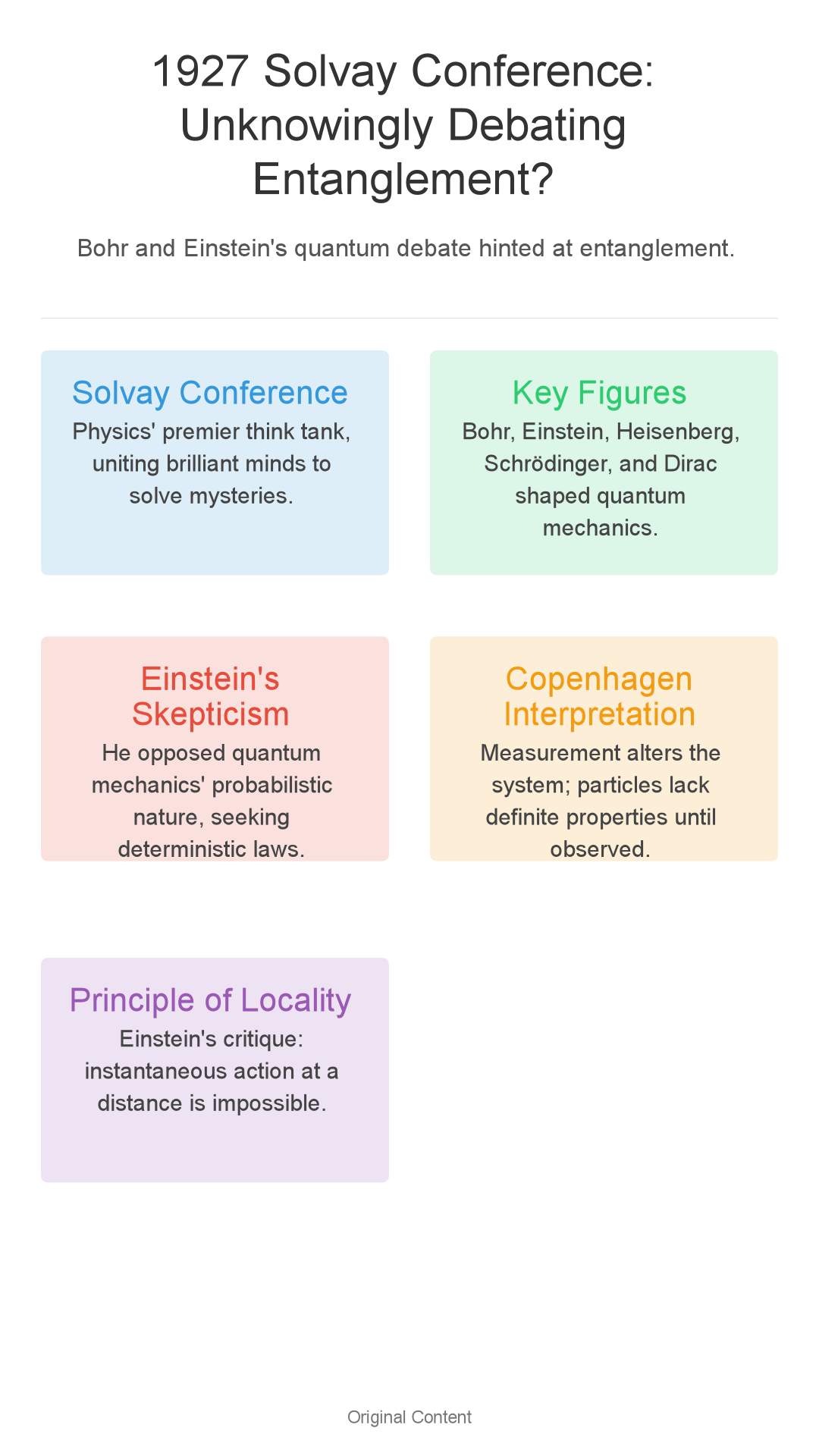
The 1927 Solvay Conference: A landmark event in physics history, where titans like Einstein and Bohr
Can history’s greatest minds stumble upon future revolutions? The 1927 Solvay Conference, a legendary clash over quantum physics, suggests they can. Prepare to have your understanding of reality challenged!
Hello, science enthusiasts and history lovers! Have you ever felt on the verge of a breakthrough, but just couldn’t quite reach it? Imagine the atmosphere at the 1927 Solvay Conference.
Picture this: physics giants—Bohr, Einstein, Heisenberg—engrossed in fervent debates about the very fabric of existence.
What if I told you that, amidst the complex equations and profound arguments, they were unknowingly circling the concept of quantum entanglement, decades before its formal discovery?
The Setting: The 1927 Solvay Conference and the Birth of the Copenhagen Interpretation
A Brief History of Physics’ Premier Think Tank
The Solvay Conferences, brainchild of Belgian industrialist Ernest Solvay, were the physics world’s equivalent of an Avengers assembly.
Held regularly, they united the most brilliant minds to confront the most perplexing unsolved mysteries. Imagine a high-stakes intellectual arena where reputations were made and scientific revolutions ignited.
The All-Star Lineup: Bohr, Einstein, and the Quantum Crew
The 1927 conference was truly *exceptional*.
We’re talking Niels Bohr, the insightful philosopher from Denmark; Albert Einstein, the master of relativity; Werner Heisenberg, the architect of the uncertainty principle; Erwin Schrödinger, of the famous cat paradox; and Paul Dirac, the quietly brilliant theorist.
Each brought a unique perspective to the burgeoning field of quantum mechanics. Einstein, a staunch believer in classical physics, harbored deep skepticism about its probabilistic nature.
Bohr, in contrast, passionately defended the new quantum paradigm.
The Copenhagen Interpretation: A Quantum Rulebook (Kind Of)
From these intense discussions emerged the Copenhagen Interpretation, championed by Bohr and Heisenberg.
This interpretation essentially posits that quantum mechanics describes the probabilities of experimental outcomes, and that the very act of measurement fundamentally alters the system being observed.
Simply put: a particle doesn’t possess definite properties until you measure them. This concept was (and remains) innovative, and Einstein remained unconvinced.
Einstein’s Challenges to Quantum Mechanics: Completeness and Locality
“God Does Not Play Dice”: Einstein’s Quantum Quandary
Einstein famously stated, “God does not play dice. ” This wasn’t a religious declaration; it was a scientific conviction.
He firmly believed that the universe operated according to deterministic laws, not random probabilities. The probabilistic nature of quantum mechanics, as interpreted by Bohr and his colleagues, deeply troubled him.
He felt it suggested that our understanding of reality was fundamentally incomplete.
The Incompleteness Argument: Something’s Missing
Einstein argued that quantum mechanics, while successful in predicting experimental results, failed to provide a complete picture of reality.
He proposed the existence of “hidden variables” that, if known, would restore determinism to the quantum realm.
He envisioned a deeper, more fundamental level of reality where everything was predetermined, and quantum mechanics was merely an approximation of this underlying order.
Locality: The Principle of No “Spooky Action”
At the heart of Einstein’s critique was the principle of locality. This principle asserts that an object is only directly influenced by its immediate surroundings.
In essence, instantaneous action at a distance is impossible. Quantum mechanics, however, seemed to contradict this principle.
When two particles are “entangled,” measuring the state of one instantly determines the state of the other, irrespective of the distance separating them.
Bohr’s Response: Complementarity and the Observer’s Role
Complementarity: Seeing Both Sides of the Quantum Coin
Bohr’s response to Einstein centered on the concept of complementarity.
He argued that quantum objects, such as electrons, can exhibit both wave-like and particle-like behavior, depending on the method of observation. These properties are complementary, meaning they cannot be observed simultaneously.
Bohr contended that attempting to force a quantum object into a classical framework was akin to trying to force a square peg into a round hole.
Bohr emphasized the pivotal role of the observer and the act of measurement in shaping quantum reality. He maintained that the properties of a quantum object are not inherent but are defined by how we choose to measure them.
The act of measurement compels the quantum object to “choose” a definite state.
Reconciling Quantum Mechanics with Reality: A New Way of Thinking
Bohr’s responses aimed to reconcile the seemingly paradoxical nature of quantum mechanics with experimental evidence.
He argued that we must abandon our classical intuitions about reality and embrace a novel way of thinking.
While Einstein sought a complete and deterministic theory, Bohr embraced the inherent uncertainty and probabilistic nature of the quantum world.
Echoes of Entanglement: The Implicit Debate
The EPR Paradox: A Seed Planted at Solvay
Although not explicitly discussed as “entanglement” at the 1927 Solvay Conference, the groundwork was laid.
The EPR paradox, published by Einstein, Podolsky, and Rosen in 1935, directly challenged the completeness of quantum mechanics by highlighting the implications of “spooky action at a distance.
” This thought experiment, though published later, directly stemmed from the Solvay debates. It proposed a scenario where measuring one entangled particle instantaneously influences the state of another, even if they are separated by vast distances.
“Spooky Action” Lurking in the Shadows
The discussions surrounding “spooky action at a distance,” while not yet formally defined, were already woven into the underlying arguments at Solvay.
Einstein’s unwavering insistence on locality and his discomfort with instantaneous correlations strongly suggested the concept of entanglement.
Although he lacked the complete mathematical framework to fully articulate it, his intuition clearly pointed towards the interconnectedness of quantum systems.
Non-Separability and Correlations: The Building Blocks of Entanglement
The concepts of non-separability and correlations were implicitly debated at Solvay.
Einstein’s arguments against the completeness of quantum mechanics rested on the assumption that separate systems should possess independent properties.
However, entanglement demonstrates that quantum systems can be inextricably linked, even when spatially separated.
The correlations between entangled particles are stronger than any classical correlations, violating Bell’s inequalities (a later development, but rooted in these early debates).
So, what are your thoughts? Did Einstein, in his relentless pursuit to disprove quantum mechanics, inadvertently illuminate one of its most profound and potentially innovative aspects? Share your insights in the comments below!

Enjoyed this? Check out our YouTube channel for video versions!
Enjoyed this? Check out our YouTube channel for video versions!



